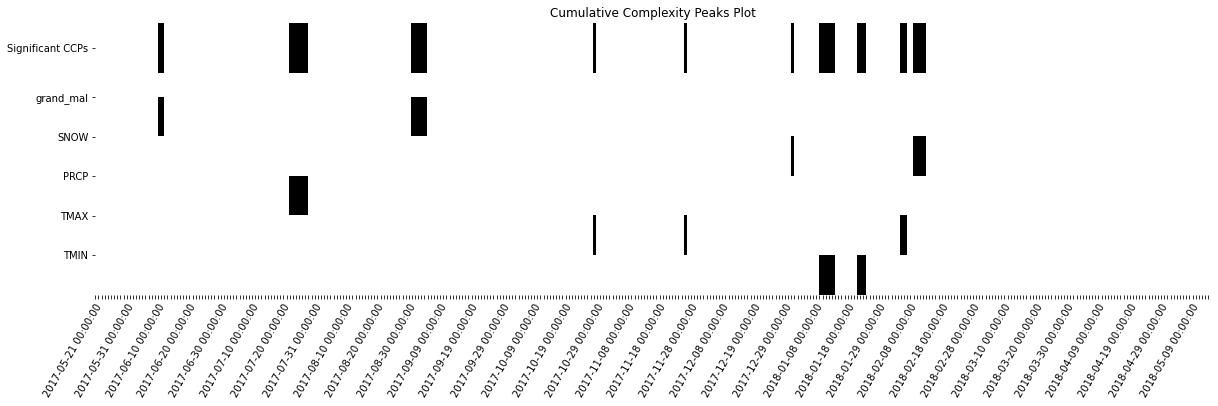Looking for patterns in grand mal seizures¶
Author: James Twose Date: 20-03-2021
Context¶
This data set is 12 months of seizure frequency data of a 20 year old male that lives in Iowa City, Iowa. He sufferers from grand mal seizures that result from Tubular Sclerosis that affects his brain. This is my nephew Michael, and I love him, and I want to access the smartest and best data resources to help provide insight and maybe support that can give him some relief.
I am providing this data in hopes of creating a contest that can help identify and predict a pattern to his seizures based on this frequency data and state (sleep/awake), and environmental data including weather, allergens, temperature, and other potential sources.
About Tubular Sclerosis¶
Tubular Sclerosis is an uncommon genetic disorder that causes noncancerous (benign) tumors — unexpected overgrowths of normal tissue — to develop in many parts of the body.
[1]:
# utility packages
from sinfo import sinfo
# data manipulation packages
import pandas as pd
import numpy as np
from sklearn.preprocessing import MinMaxScaler
# plotting packages
import matplotlib.pyplot as plt
import matplotlib.patches as patches
import seaborn as sns
#analysis packages
from scipy.spatial import distance_matrix
from jmspack.NLTSA import (ts_levels,
distribution_uniformity,
fluctuation_intensity,
complexity_resonance,
complexity_resonance_diagram,
cumulative_complexity_peaks,
cumulative_complexity_peaks_plot)
from dtw import dtw, rabinerJuangStepPattern
from pyrqa.time_series import TimeSeries
from pyrqa.settings import Settings
from pyrqa.analysis_type import Classic
from pyrqa.neighbourhood import FixedRadius
from pyrqa.metric import EuclideanMetric
from pyrqa.computation import RQAComputation
from pyrqa.computation import RPComputation
from pyrqa.image_generator import ImageGenerator
Importing the dtw module. When using in academic works please cite:
T. Giorgino. Computing and Visualizing Dynamic Time Warping Alignments in R: The dtw Package.
J. Stat. Soft., doi:10.18637/jss.v031.i07.
[2]:
sinfo(write_req_file=False)
-----
dtw 1.1.6
jmspack 0.0.2
matplotlib 3.3.4
numpy 1.19.2
pandas 1.2.3
pyrqa NA
scipy 1.6.1
seaborn 0.11.1
sinfo 0.3.1
sklearn 0.23.2
-----
IPython 7.21.0
jupyter_client 6.1.7
jupyter_core 4.7.1
jupyterlab 3.0.10
notebook 6.2.0
-----
Python 3.8.8 (default, Feb 24 2021, 13:46:16) [Clang 10.0.0 ]
macOS-10.16-x86_64-i386-64bit
12 logical CPU cores, i386
-----
Session information updated at 2021-03-21 21:16
[3]:
interesting_weather_columns = ['NAME', 'SNOW', 'PRCP',
'TMAX',
'TMIN',
'timestamp']
[4]:
weather_df = (pd.read_csv("iowa_weather.csv")
.assign(timestamp = lambda x : pd.to_datetime(x["DATE"]))
.loc[:, interesting_weather_columns]
)
[5]:
mal_df = (pd.read_excel("MB_SeizureRecords.xlsx", index_col=0)
.loc[1:72, :]
.assign(timestamp = lambda x : pd.to_datetime(x["DATE"]))
.loc[:, ["timestamp", "STATE"]]
.reset_index(drop=True)
.assign(grand_mal = 1)
)
mal_df.columns = [x.lower() for x in mal_df.columns]
[6]:
all_times = pd.date_range(mal_df["timestamp"].min(),
mal_df["timestamp"].max(), freq = "d")
[7]:
troublesome_ts = (mal_df
.groupby("timestamp")
.count()
.loc[:, "grand_mal"]
.sort_values(ascending=False)
.head(9)
.index
.tolist()
)
[8]:
both_ts = (mal_df[mal_df["timestamp"].isin(troublesome_ts)]
.value_counts()
.reset_index()
.groupby("timestamp")
.count()
.sort_values("state")
.tail(4)
.index
.tolist()
)
[9]:
mals = (mal_df
.groupby("timestamp")
.count()
.loc[:, ["grand_mal"]]
)
states = (mal_df
.groupby("timestamp")
.head(1)
.set_index("timestamp")
.loc[:, ["state"]]
)
_df = pd.merge(mals, states, left_index=True, right_index=True)
_df.loc[both_ts, "state"] = "both"
[10]:
_df = _df.reindex(all_times)
[11]:
_df.loc[_df["grand_mal"].isna(), "grand_mal"] = 0
[12]:
df = pd.merge(_df,
weather_df[weather_df["NAME"].str.contains("IOWA CITY, IA US")],
how="left",
left_index=True,
right_on="timestamp"
).set_index("timestamp")
[13]:
_ = plt.figure(figsize=(30, 5))
_ = sns.heatmap(df.drop(["state", "NAME"], axis=1).T)

RQA plotting¶
[14]:
scale_cols = interesting_weather_columns[1:-1] + ["grand_mal"]
[15]:
scale_cols
[15]:
['SNOW', 'PRCP', 'TMAX', 'TMIN', 'grand_mal']
[33]:
# for feature in scale_cols:
# # feature = "grand_mal"
# # feature = "TMIN"
# data_points = df[feature].values.tolist()
# time_series = TimeSeries(data_points,
# embedding_dimension=1,
# time_delay=1)
# settings = Settings(time_series,
# analysis_type=Classic,
# neighbourhood=FixedRadius(0.65),
# similarity_measure=EuclideanMetric,
# theiler_corrector=1)
# computation = RQAComputation.create(settings,
# verbose=False)
# result = computation.run()
# computation = RPComputation.create(settings)
# result = computation.run()
# ImageGenerator.save_recurrence_plot(result.recurrence_matrix_reverse,
# f'Img/{feature}_recurrence_plot.png')
TS_levels¶
[17]:
df.info()
<class 'pandas.core.frame.DataFrame'>
DatetimeIndex: 359 entries, 2017-05-21 to 2018-05-14
Data columns (total 7 columns):
# Column Non-Null Count Dtype
--- ------ -------------- -----
0 grand_mal 359 non-null float64
1 state 60 non-null object
2 NAME 359 non-null object
3 SNOW 359 non-null float64
4 PRCP 359 non-null float64
5 TMAX 358 non-null float64
6 TMIN 357 non-null float64
dtypes: float64(5), object(2)
memory usage: 30.5+ KB
[18]:
def scale_df(x):
return pd.DataFrame(MinMaxScaler().fit_transform(x), columns=x.columns, index=x.index)
[19]:
df[scale_cols] = scale_df(df[scale_cols])
[20]:
feature_selection = scale_cols #+ ["grand_mal"]
ts_df = df.drop(["state", "NAME"], axis=1).dropna().reset_index()
[21]:
all_ts_levels = pd.DataFrame()
for column in feature_selection:
ts_levels_df, fig, ax = ts_levels(ts=ts_df[column],
ts_x=None,
criterion="mse",
max_depth=10,
min_samples_leaf=15,
min_samples_split=2,
max_leaf_nodes=30,
plot=False,
equal_spaced=True,
n_x_ticks=10)
_ = ts_levels_df.set_index("t_steps", inplace=True)
ts_levels_df.columns = [f"{column}_{x}" for x in ts_levels_df.columns.tolist()]
all_ts_levels = pd.concat([all_ts_levels, ts_levels_df], axis=1)
[22]:
plot_df = (pd.merge(ts_df["timestamp"].reset_index(drop=True),
all_ts_levels,
left_index=True,
right_index=True)
.melt(id_vars="timestamp"))
[23]:
ax = sns.scatterplot(x="timestamp",
y="value",
hue="variable",
palette="gist_rainbow",
data=plot_df[plot_df["variable"].str.contains("grand_mal")],
)
ax = sns.lineplot(x="timestamp",
y="value",
hue="variable",
palette="gist_rainbow",
data=plot_df[plot_df["variable"].str.contains("grand_mal")],
)
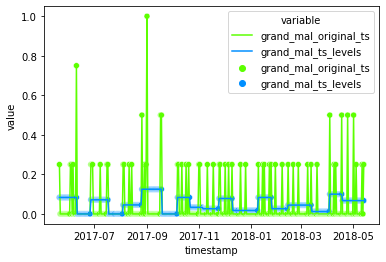
[24]:
plt.figure(figsize=(30, 10))
height=1
ax = sns.scatterplot(x="timestamp",
y="value",
hue="variable",
palette="gist_rainbow",
data=plot_df[plot_df["variable"].str.contains("original_ts")],
legend=False,
linestyle='dashed',
)
ax = sns.lineplot(x="timestamp",
y="value",
hue="variable",
palette="gist_rainbow",
data=plot_df[plot_df["variable"].str.contains("ts_levels")],
)
_ = ax.set(xlabel='Date', ylabel='Scaled Values',
title=f'Weather and grand mal occurence ts levels')
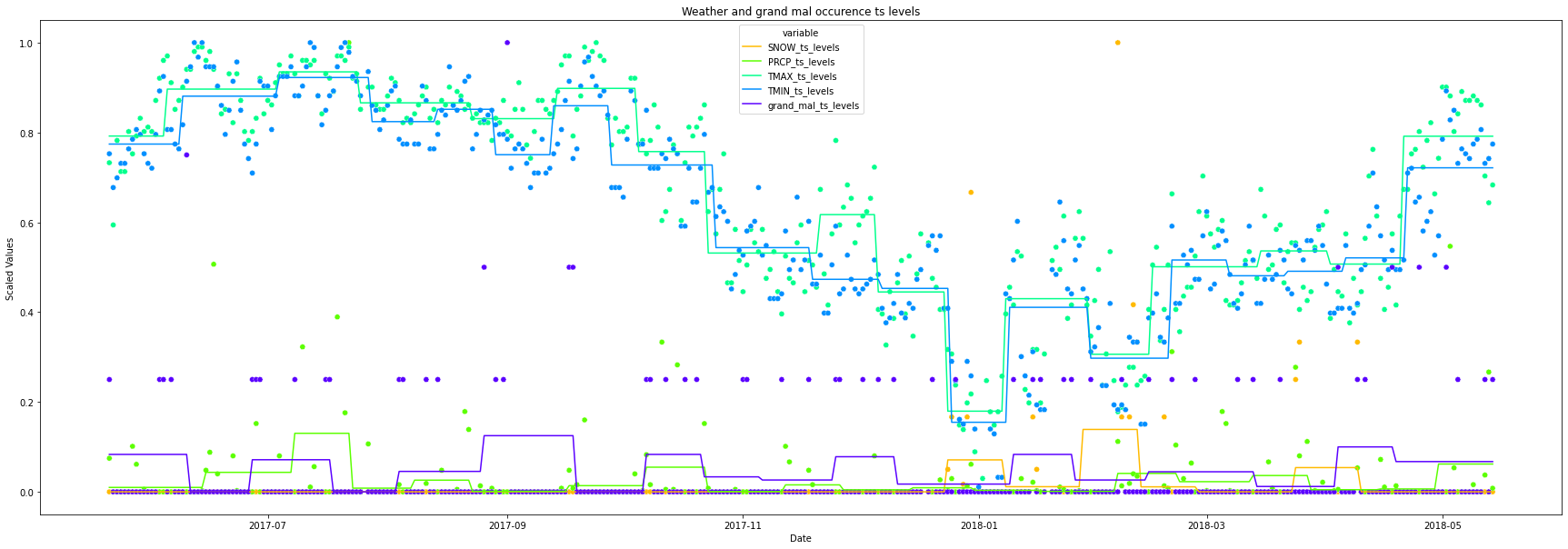
Dynamic time warping of ts levels time series¶
[25]:
template = plot_df[plot_df["variable"].str.contains("grand_mal_ts_levels")].value.values
query = plot_df[plot_df["variable"].str.contains("PRCP_ts_levels")].value.values
# template = plot_df[plot_df["variable"].str.contains("TMAX_ts_levels")].value.values
# query = plot_df[plot_df["variable"].str.contains("TMIN_ts_levels")].value.values
# template = plot_df[plot_df["variable"].str.contains("TMAX_ts_levels")].value.values
# query = plot_df[plot_df["variable"].str.contains("TMAX_ts_levels")].value.values
[26]:
len(query), len(template)
[26]:
(356, 356)
[27]:
## Find the best match with the canonical recursion formula
alignment = dtw(query, template, keep_internals=True)
## Display the warping curve, i.e. the alignment curve
_ = alignment.plot(type="threeway")
## Align and plot with the Rabiner-Juang type VI-c unsmoothed recursion
dtw(query, template, keep_internals=True,
step_pattern=rabinerJuangStepPattern(1, "c"))\
.plot(type="twoway",offset=-2)
# ## See the recursion relation, as formula and diagram
# print(rabinerJuangStepPattern(6,"c"))
# rabinerJuangStepPattern(6,"c").plot()
alignment.distance
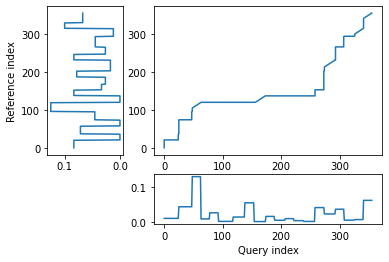
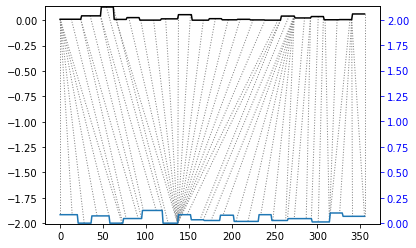
[27]:
10.25423849434186
[28]:
ax = sns.lineplot(x="timestamp",
y="value",
# hue="variable",
palette="gist_rainbow",
data=plot_df[plot_df["variable"].str.contains("grand_mal_ts_levels")],
)
ax = sns.lineplot(x="timestamp",
y="value",
# hue="variable",
palette="gist_rainbow",
data=plot_df[plot_df["variable"].str.contains("PRCP_ts_levels")],
)
_ = ax.set(xlabel='Date', ylabel='Scaled Values',
title=f'Weather and grand mal occurence ts levels')
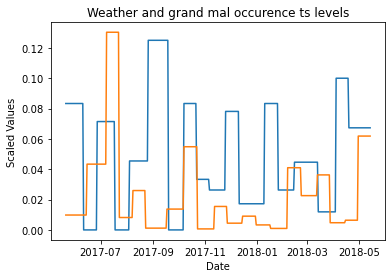
Dynamic Complexity¶
[29]:
fluctuation_intensity_df = fluctuation_intensity(df=ts_df.set_index("timestamp"),
win=7,
xmin=0,
xmax=1,
col_first=1,
col_last=ts_df.shape[1]-1)
distribution_uniformity_df = distribution_uniformity(df=ts_df.set_index("timestamp"),
win=7,
xmin=0,
xmax=1,
col_first=1,
col_last=ts_df.shape[1]-1)
complexity_resonance_df = complexity_resonance(fluctuation_intensity_df, distribution_uniformity_df)
[30]:
_ = complexity_resonance_diagram(fluctuation_intensity_df, plot_title='Fluctuation Intensity Diagram', figsize=(30, 7))
_ = complexity_resonance_diagram(distribution_uniformity_df, plot_title='Distribution Uniformity Diagram', figsize=(30, 7))
_ = complexity_resonance_diagram(complexity_resonance_df, figsize=(30, 7))

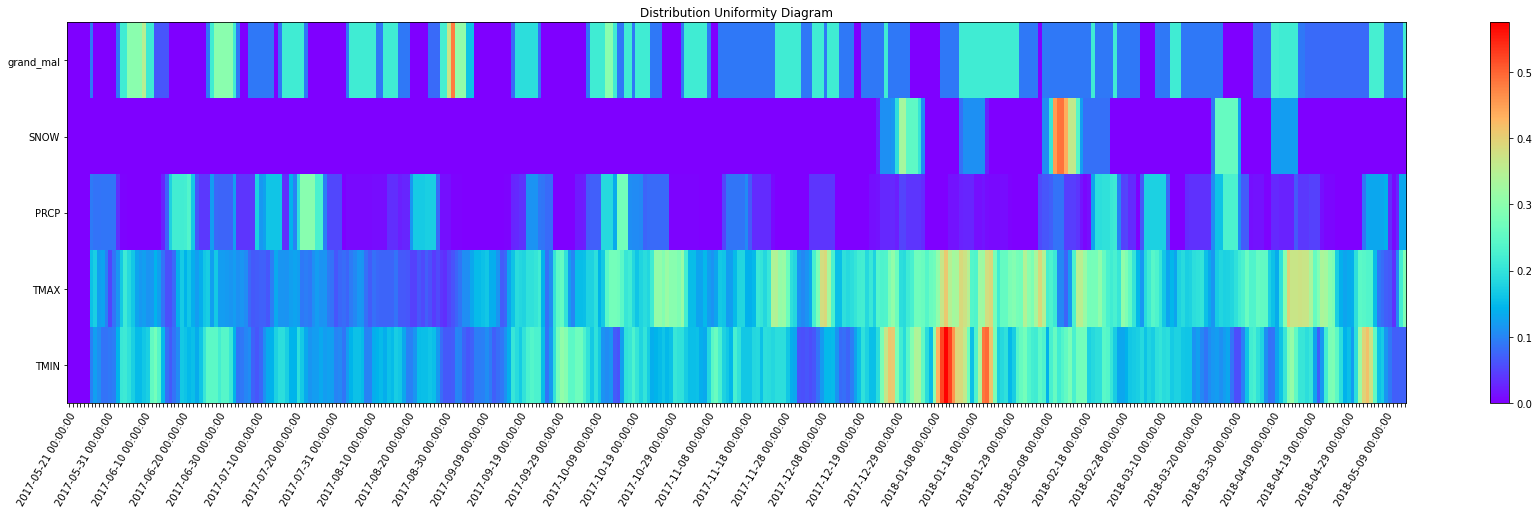

[31]:
cumulative_complexity_peaks_df, significant_peaks_df = cumulative_complexity_peaks(df=complexity_resonance_df,
significant_level_item = 0.001,
significant_level_time = 0.05,)
[32]:
_ = cumulative_complexity_peaks_plot(cumulative_complexity_peaks_df,
significant_peaks_df,
figsize=(20,5),
height_ratios=[1,4])
